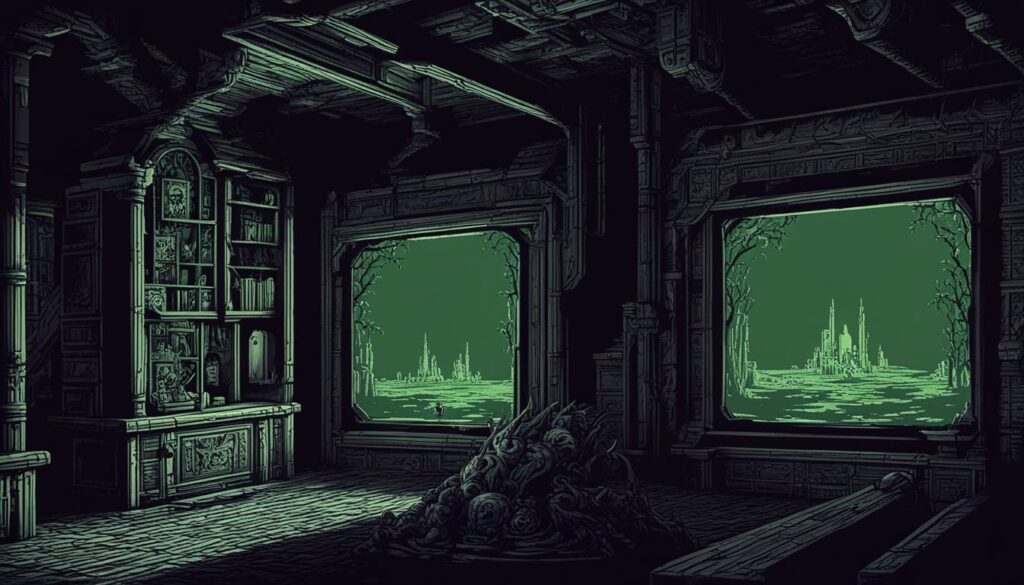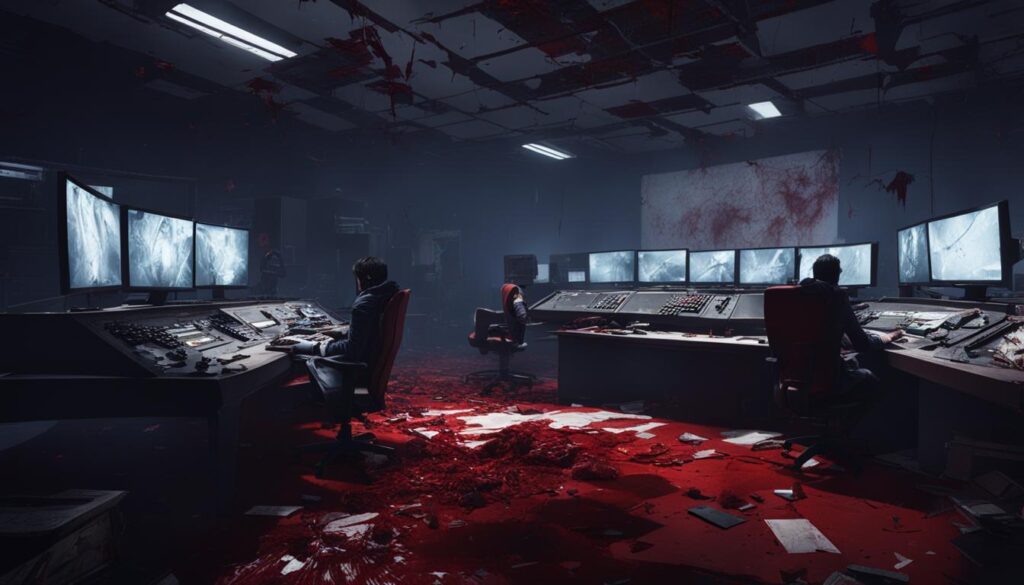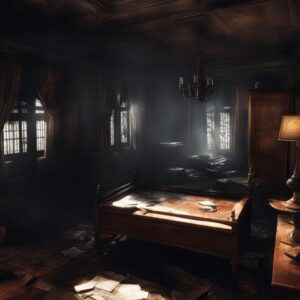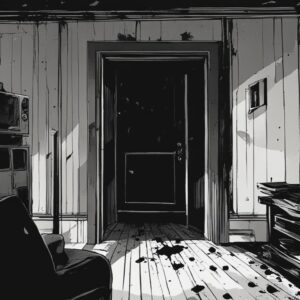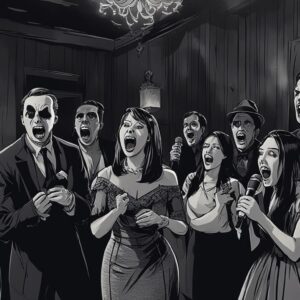Indie horror game design has taken the gaming world by storm, offering developers the freedom to create uniquely terrifying experiences. As an avid horror game enthusiast, I have come up with some of my best ideas for horror game development. From spine-chilling narratives to innovative gameplay mechanics, these ideas aim to push the boundaries and unleash your darkest fears.
Key Takeaways:
- Indie horror game design allows for unprecedented creativity and the exploration of unique terrains.
- Games like Amnesia: The Dark Descent and Slender: The Eight Pages pioneered the indie horror genre.
- Creativity is the driving force behind successful indie horror games, enabling developers to break free from market trends and create truly terrifying experiences.
- Indie horror games excel in unique storytelling, offering immersive and emotionally charged narratives.
- Implementing fear in gameplay is a skill indie developers have mastered, resulting in innovative mechanics that keep players on the edge of their seats.
The Roots of Indie Horror
When it comes to indie horror game design, we can’t ignore the influential roots that have shaped the genre. Two standout titles, Amnesia: The Dark Descent and Slender: The Eight Pages, played a pivotal role in setting the stage for indie developers to showcase their creative prowess.
Amnesia: The Dark Descent brought psychological horror to the forefront, immersing players in a terrifying journey filled with atmospheric tension and heart-pounding encounters. The game’s emphasis on exploration and survival, coupled with its masterful storytelling, pushed the boundaries of horror gaming.
“Amnesia was a game-changer for indie horror. Its haunting atmosphere and innovative gameplay mechanics proved that indie developers could create experiences that rivaled those of major studios.” – GamePro Magazine
Similarly, Slender: The Eight Pages captivated players with its minimalist design and creeping sense of dread. The game’s focus on atmospheric horror and the fear of the unknown created an unforgettable experience that resonated with players around the world.
These games demonstrated that indie developers had the creative freedom to craft unique horror experiences that stood shoulder to shoulder with triple-A titles. Their success paved the way for a new era of indie horror game design, inspiring developers to push the boundaries even further and explore the depths of terror.
| Game | Description | Release Date |
|---|---|---|
| Amnesia: The Dark Descent | A first-person survival horror game | September 8, 2010 |
| Slender: The Eight Pages | A first-person horror game | June 26, 2012 |
When Creativity Meets Horrors
In the realm of indie horror game design, creativity is the driving force behind the most captivating and terrifying experiences. Unlike mainstream titles, indie developers have the freedom to explore their darkest imaginations without the constraints of market trends or broad appeal. This unrestricted creativity has given rise to a new wave of horror games that defy traditional norms and offer players unique narratives and innovative mechanics.
Indie horror games have become a breeding ground for unconventional storytelling techniques. These games delve into themes rarely explored in mainstream titles, offering players more personal, intimate, and emotionally charged experiences. From games that explore the depths of human psychology to those that delve into the supernatural, indie horror games push the boundaries of storytelling, immersing players in haunting narratives that leave a lasting impact.
What sets indie horror games apart is their willingness to experiment with gameplay mechanics. These games are constantly pushing the boundaries of what is considered “scary,” incorporating innovative mechanics that keep players on the edge of their seats. Whether it’s the absence of traditional weapons, time-driven challenges, or relentless narratives that unfold in real-time, indie horror games excel at destabilizing players and creating an atmosphere of constant unease.
Innovative Mechanics and Unique Narratives
One example of the intersection between creativity and horror is the critically acclaimed indie game “Amnesia: The Dark Descent.” This game not only introduced a new level of horror in gaming but also revolutionized the genre with its unique gameplay mechanics. Players were stripped of their ability to defend themselves, relying solely on their wits to navigate the terrifying world. The game’s atmospheric sound design, combined with its innovative narrative structure, created an immersive experience that still resonates with players today.
“Indie horror games allow developers to unleash their creativity and explore new ways to terrify players. These games often tell stories that are deeply personal and emotionally charged, challenging players to confront their fears head-on. From the psychological horror of ‘Silent Hill’ to the existential dread of ‘Inside,’ indie horror games offer a unique perspective on the genre and continue to push the boundaries of what is possible in interactive storytelling.” – Game Developer Magazine
The Future of Indie Horror
The future of indie horror game design is an exciting prospect. With advancements in technology and the rise of virtual reality, developers have even more tools at their disposal to create immersive and terrifying experiences. VR horror games, in particular, offer a new level of immersion, allowing players to step into the nightmarish worlds they once only observed from a distance. As the demand for unique narratives and innovative mechanics continues to grow, indie horror games will play a vital role in shaping the future of the gaming industry.
Unique Storytelling in Indie Horror
Indie horror games have captivated players with their unique storytelling approaches, offering narratives that delve deep into unexplored themes. Unlike mainstream games, indie developers have the creative freedom to craft intimate and emotionally charged experiences that leave a lasting impact.
One example of indie horror’s unique storytelling can be seen in the critically acclaimed game “Layers of Fear.” The game immerses players in the mind of a tormented painter, unraveling a haunting tale of madness and obsession. Through cleverly designed environments and a non-linear narrative structure, “Layers of Fear” challenges players to piece together a fragmented story, resulting in a deeply unsettling and thought-provoking experience.
Another standout title is “What Remains of Edith Finch,” which tells the tragic story of the ill-fated Finch family through a series of interconnected vignettes. Each vignette offers a unique gameplay perspective and storytelling technique, immersing players in the lives and tragedies of the Finch family members. This unconventional narrative structure creates a profound sense of empathy and connection, making “What Remains of Edith Finch” a standout example of indie horror’s ability to deliver impactful and emotionally resonant storytelling.
Importance of Unique Storytelling in Indie Horror
The emphasis on unique storytelling in indie horror games is vital to the genre’s continued growth and success. By pushing the boundaries of traditional horror narratives, indie developers can offer fresh and original experiences that stand out in an oversaturated market. This emphasis on storytelling also allows indie horror games to explore complex themes, challenge societal norms, and create thought-provoking commentary on the human condition.
Ultimately, it is the personal and intimate nature of indie horror’s storytelling that sets it apart from mainstream titles. Through the use of immersive environments, compelling characters, and innovative narrative techniques, indie horror games can transport players to unsettling and emotionally charged worlds, leaving a lasting impact that resonates long after the game has ended.
Whether it’s unraveling the mysteries of a haunted house, confronting personal demons, or exploring the depths of psychological horror, indie horror games continue to push the boundaries of storytelling, creating unforgettable experiences for players.
Strategies of Terror: Implementing Fear in Gameplay
Indie horror game design is a masterclass in implementing fear into gameplay. Developers in this genre have crafted innovative mechanics and gameplay elements that keep players on the edge of their seats. Whether it’s the absence of traditional weaponry in games like Outlast or the time-driven mechanics of Five Nights at Freddy’s, indie horror games excel at creating a sense of dread and discomfort. These games challenge players to rely on their wits and survival instincts as they navigate through terrifying scenarios.
One standout example of fear-inducing gameplay is the critically acclaimed game Soma. In Soma, players are thrust into a dystopian underwater facility filled with monsters and mysteries. The relentless narrative drives the fear factor, as players must confront their deepest fears and make life-or-death decisions. The game’s atmospheric setting, coupled with its thought-provoking storytelling, immerses players in a world where fear lurks around every corner.
Another hallmark of indie horror game design is the use of innovative mechanics to intensify the fear factor. Games like Little Nightmares and Inside employ unique puzzle-solving gameplay that adds an extra layer of tension. As players unravel the mysteries within these eerie worlds, the fear of the unknown and the impending danger keeps them engaged and invested in the experience. The combination of atmospheric visuals, haunting sound design, and clever gameplay mechanics creates a truly immersive and terrifying gameplay experience.
Strategies of Terror in Indie Horror Games:
- Non-reliance on traditional weapons or combat
- Time-driven mechanics that create a sense of urgency
- Relentless narratives that keep players engaged
- Unique puzzle-solving gameplay
- Atmospheric visuals and haunting sound design
“Indie horror game design pushes the boundaries of fear, employing innovative mechanics and immersive storytelling to create unforgettable experiences.” – Game enthusiast
The implementation of fear in gameplay is an art form that indie horror game developers have perfected. By utilizing innovative mechanics, atmospheric visuals, and compelling narratives, these games immerse players in a world of terror. The genre continues to evolve, promising even more spine-chilling experiences in the future.
Influence of Indie Horror on the Gaming Industry
Indie horror games have made a significant impact on the gaming industry, pushing boundaries and inspiring both indie developers and major studios alike. These games have paved the way for unique storytelling and innovative gameplay, revolutionizing the horror genre. The demand for rich narratives and immersive experiences has contributed to a more diverse gaming industry, where players can explore the depths of fear and embark on unforgettable journeys.
One of the key ways in which indie horror games have influenced the gaming industry is by inspiring other developers to create their own horror titles. The success of indie games such as “Amnesia: The Dark Descent” and “Slender: The Eight Pages” demonstrated that a small team with limited resources could create experiences that rival those of big-budget games. This has led to a surge in indie horror game development, with developers embracing the freedom to experiment and unleash their creativity.
Moreover, the impact of indie horror games has not been limited to the indie scene. Major studios have taken note of the success and popularity of these games, incorporating elements of indie horror into their triple-A titles. From atmospheric environments and psychological terror to unique gameplay mechanics, the influence of indie horror can be seen in games across various genres. This cross-pollination has resulted in a more diverse gaming landscape, offering players a wider range of horror experiences to choose from.
| Indie Horror’s Influence on the Gaming Industry | Examples of Influence |
|---|---|
| 1. Inspiring other indie developers | – Games like “Amnesia: The Dark Descent” and “Slender: The Eight Pages” inspired countless indie developers to create their own horror games. |
| 2. Integration of indie horror elements in triple-A titles | – Major studios have incorporated atmospheric environments, psychological terror, and unique gameplay mechanics inspired by indie horror games into their triple-A titles. |
| 3. Diversification of horror experiences | – The influence of indie horror has led to a wider range of horror experiences, offering players more diverse and unique gameplay. |
In conclusion, indie horror games have had a profound influence on the gaming industry, inspiring developers to embrace creativity and storytelling. These games have not only influenced the indie scene but have also permeated the mainstream, shaping the way horror games are created and experienced. Whether it’s the chilling narratives or the innovative mechanics, the impact of indie horror can be felt throughout the gaming industry, making it an integral part of the evolving landscape.
The Future of Indie Horror Game Design
As technology continues to advance and new gaming platforms emerge, the future of indie horror game design holds exciting possibilities. One of the most intriguing developments is the rise of virtual reality (VR) horror games. With VR technology, players can immerse themselves in terrifying and realistic environments, heightening the intensity and fear factor of the gaming experience. VR horror games offer a new level of immersion, allowing players to feel like they are truly part of the horror narrative.
Another aspect to look forward to in the future of indie horror game design is the exploration of innovative gameplay mechanics. Indie developers have always been known for their ability to think outside the box and create unique gaming experiences. In the world of horror games, this means pushing the boundaries of what is considered “normal” and introducing fresh gameplay elements that keep players engaged and on the edge of their seats. Whether it’s the integration of puzzle-solving mechanics, interactive decision-making, or dynamic enemy behaviors, the future of indie horror games promises innovation and surprises.
Furthermore, the blending of horror with other genres is becoming increasingly popular. Cross-genre hybrids that infuse horror with elements of survival, RPG, or action genres are giving rise to entirely new subgenres within the indie horror game landscape. These creative combinations offer fresh perspectives and gameplay experiences that appeal to a wider audience while still delivering the scares and thrills that horror enthusiasts crave.
Table: Top Upcoming Indie Horror Games
| Title | Platform | Release Date |
|---|---|---|
| Phasmophobia | PC | 2020 |
| In Sound Mind | PC, Xbox, PlayStation | 2021 |
| Scorn | PC, Xbox | 2021 (TBD) |
These upcoming indie horror games demonstrate the potential for innovative gameplay and terrifying experiences. Each game offers its own unique blend of horror elements and showcases the talent and creativity of indie developers. From Phasmophobia’s paranormal investigations to In Sound Mind’s psychological horrors and Scorn’s disturbing and atmospheric world, the future of indie horror game design looks bright.
Fear Factor Unleashed: A Chaotic Game Adaptation
Fear Factor Unleashed was a Game Boy Advance game released in 2004, based on the popular reality show Fear Factor. As a fan of the show, I was excited to dive into this game and experience the thrill of facing daring challenges and pushing my limits. However, upon playing, it quickly became apparent that Fear Factor Unleashed failed to capture the essence and excitement of the show.
The game followed the structure of the reality show, where players competed in various challenges and mini-games. Unfortunately, the gameplay quickly became repetitive, with the same challenges being played over and over again. This lack of variety diminished the overall excitement and thrill that fans of the show were expecting.
“Fear Factor Unleashed failed to capture the essence and excitement of the show.”
Another disappointment with Fear Factor Unleashed was the AI-controlled contestants. Instead of being able to fully engage in the challenges against other human players, the game relied on AI-controlled opponents to compete against. This led to long load times and repetitive performances by the AI, making the gameplay monotonous and predictable.
Overall, Fear Factor Unleashed was a missed opportunity to create an exciting and innovative adaptation of the popular reality show. The repetitive gameplay and lack of innovation left players craving for a more thrilling and authentic experience. While it may serve as a nostalgic reminder of the show for some, it ultimately falls short of capturing the true excitement and adrenaline rush of Fear Factor.
The Challenges of Fear Factor Unleashed
Fear Factor Unleashed, a Game Boy Advance game released in 2004, aimed to capture the excitement of the popular reality show. However, it faced several challenges that hindered its overall gameplay experience. One of the main drawbacks was the presence of AI-controlled contestants, which became a source of frustration for players. The lack of an option to fully turn off AI turns resulted in long load times and repetitive performances by the AI, making the gameplay monotonous.
The simplicity of the mini-games further contributed to the game’s repetitive nature. Players expected more challenging and thrilling tasks that would recreate the adrenaline rush of the actual Fear Factor show. Unfortunately, Fear Factor Unleashed fell short in terms of innovation, failing to capitalize on the potential for dynamic and exciting gameplay.
To summarize, Fear Factor Unleashed faced significant challenges due to its reliance on AI-controlled contestants and repetitive gameplay. The absence of more complex mini-games and innovative elements left players craving a more immersive and engaging experience. As a result, the game failed to capture the true essence of the Fear Factor franchise and left players disappointed.
Missed Opportunities in Fear Factor Unleashed
Fear Factor Unleashed, despite its attempt to adapt the thrilling reality show to the gaming world, missed several opportunities for innovation and excitement. The game showcased repetitive gameplay and lacked the tension and thrill that made the Fear Factor show so captivating. With a few key improvements, the developers could have created a truly immersive and adrenaline-pumping gaming experience.
One of the missed opportunities in Fear Factor Unleashed was the lack of more thrilling challenges. The mini-games featured in the game were simple and failed to capture the intensity and excitement of the actual Fear Factor show. The developers could have designed a wider variety of challenges that truly tested the players’ skills and nerves, creating a more engaging and adrenaline-fueled experience.
Additionally, the game could have benefited from more dynamic AI behavior. The AI-controlled contestants in Fear Factor Unleashed often performed repetitive actions, leading to a monotonous gameplay experience. By incorporating more adaptive AI, the developers could have created a more realistic and challenging competition, where each contestant reacted differently to the obstacles and posed a unique threat to the player.
Missed Opportunities in Fear Factor Unleashed
| Missed Opportunity | Description |
|---|---|
| More Thrilling Challenges | The mini-games lacked excitement and failed to capture the intensity of the Fear Factor show. |
| Dynamic AI Behavior | The AI-controlled contestants performed repetitive actions, resulting in a monotonous gameplay experience. |
Overall, Fear Factor Unleashed had the potential to be a thrilling adaptation of the reality show, but it fell short in delivering an innovative and captivating gaming experience. By incorporating more exciting challenges and dynamic AI behavior, the game could have provided players with the adrenaline rush they were expecting. It serves as a reminder of the importance of innovation and creativity in capturing the true essence of fear in gaming.
Fear Factor Unleashed: An Adequate Palate Cleanser
While Fear Factor Unleashed received negative reviews and was considered shovelware, it served as a palate cleanser for those seeking unlikable kusoge. The game’s mediocre gameplay and lack of innovation reminded players of the importance of well-designed horror games that capture the true essence of fear.
Released in 2004 for the Game Boy Advance, Fear Factor Unleashed was an adaptation of the popular reality show Fear Factor. However, the game failed to capture the excitement and thrill of the show, resulting in disappointment among players. With its repetitive gameplay and lack of innovative features, Fear Factor Unleashed fell short of satisfying gamers’ expectations.
Despite its shortcomings, Fear Factor Unleashed had its place in the gaming landscape. The game’s unlikable kusoge status served as a reminder that not all horror games are created equal. It highlighted the need for well-designed horror experiences that truly evoke fear and provide players with engaging gameplay mechanics.
Take a look at the table below for a visual comparison of Fear Factor Unleashed and other horror games:
| Game Title | Gameplay | Innovation | Fear Factor |
|---|---|---|---|
| Fear Factor Unleashed | Mediocre and repetitive | Lack of innovation | Minimal fear factor |
| Outlast | Intense and immersive | Innovative use of night vision camera | High fear factor |
| Amnesia: The Dark Descent | Psychological horror and exploration | Unique sanity system | Elevated fear factor |
| Silent Hill | Tense atmosphere and psychological horror | Twisted monster designs | Intense fear factor |
As shown in the table, Fear Factor Unleashed pales in comparison to other horror games when it comes to gameplay, innovation, and its ability to generate fear. It serves as a reminder of the importance of quality horror game design and the need for developers to push the boundaries of creativity in order to truly captivate players and evoke genuine fear.
Haunting Story Ideas for Scary Movies
When it comes to creating terrifying and suspenseful stories, the world of scary movies offers a myriad of possibilities. From haunted house tales to psychological horror concepts, the genre allows filmmakers to tap into our deepest fears and explore the realms of the supernatural. Here are some haunting story ideas that could make for spine-chilling and unforgettable scary movies.
The Cursed Doll
In a small town, a family inherits an antique doll that soon reveals its sinister nature. As strange occurrences and unexplained phenomena plague their home, the family must uncover the dark secrets behind the cursed doll before it claims their lives. This haunting tale delves into the fear of inanimate objects coming to life and the terror of an ancient evil that cannot be escaped.
The Stalked Friends
A group of friends on a weekend getaway finds themselves being relentlessly pursued by a masked killer. As they fight to survive, tensions rise, trust is shattered, and dark secrets are revealed. This suspenseful story not only explores the fear of a relentless stalker, but also delves into the horror of betrayal and the lengths people will go to protect themselves.
These are just a few ideas to spark the imagination and send shivers down your spine. The beauty of scary movies lies in their ability to tap into our primal fears and take us on a thrilling journey into the unknown. Whether it’s a haunted house, a psychological mind-bender, or a supernatural entity, the possibilities for terrifying and captivating stories are endless.
Psychological Horror: Exploring the Depths of Fear
The realm of psychological horror delves into the deepest corners of the human mind, unraveling the fears and anxieties that reside within. These stories go beyond jump scares and gory visuals, instead, they tap into the psychological terror that stems from the fear of the unknown. By leveraging the power of the mind, psychological horror captivates audiences with its ability to distort reality, leaving them questioning their own sanity.
In these narratives, ordinary individuals are thrust into extraordinary circumstances, facing their deepest fears and confronting the darkness that lurks within themselves. Suspense, tension, and the unexpected play key roles in creating a truly chilling experience. From subtle and atmospheric approaches to mind-bending twists, psychological horror keeps us on the edge of our seats, wondering what horrors await us around the next corner.
“The most merciful thing in the world, I think, is the inability of the human mind to correlate all its contents.” – H.P. Lovecraft
An effective way to enhance the psychological horror experience is to introduce elements of the unknown. Whether it’s an unexplainable presence, a mysterious force, or a descent into madness, the fear of what lies in the shadows can be more terrifying than the reveal itself. By keeping the audience in a constant state of uncertainty, psychological horror instills a sense of dread that lingers long after the story has ended.
| Psychological Horror Story Ideas |
|---|
| A woman wakes up every day experiencing a different reality, unsure of what is real and what is a figment of her imagination. |
| A man begins receiving anonymous messages that gradually reveal dark secrets about his past, leading him down a dangerous path of self-discovery. |
| After a near-death experience, a young girl starts seeing a doppelganger of herself, slowly driving her to question her own identity and sanity. |
| A group of strangers find themselves trapped in a haunted asylum, forced to confront their deepest fears and face the horrors within. |
These story ideas serve as a starting point for crafting captivating psychological horror experiences. By exploring the depths of fear and tapping into the unknown, these narratives have the potential to leave a lasting impact on audiences, reminding them of the power of the human mind and the terrifying realities that lie within.
Conclusion
In conclusion, the world of horror game development is constantly evolving, with indie developers leading the way in pushing the boundaries of creativity and storytelling. Through their unique gameplay mechanics and immersive experiences, indie horror games have captivated players and redefined how we experience fear.
From exploring the depths of psychological horror to implementing innovative gameplay mechanics that keep players on the edge of their seats, indie horror game designers continue to surprise and terrify us. The future of indie horror game design looks promising, with advancements in technology and expanding platforms opening up new possibilities for terrifying experiences.
As players and creators, we have the power to unleash our fears and immerse ourselves in the dark and imaginative worlds of indie horror games. With their unique narratives and innovative mechanics, these games have cemented their place in the gaming industry and inspired other developers to explore the horror genre in exciting new ways.
So whether you’re a fan of heart-pounding jump scares, chilling narratives, or innovative gameplay, the world of indie horror game development has something for everyone. It’s time to dive into the unknown, confront our fears, and experience the thrill of indie horror at its finest.
FAQ
What is indie horror game design?
Indie horror game design refers to the creative process of developing horror video games by independent developers. These games often explore unique and terrifying scenarios, pushing the boundaries of traditional horror.
What are some famous indie horror games?
Some famous indie horror games include Amnesia: The Dark Descent and Slender: The Eight Pages. These games played a significant role in shaping the indie horror genre and showcasing the potential of independent developers.
What sets indie horror games apart from mainstream horror games?
Indie horror games have the freedom to explore dark and imaginative ideas without conforming to market trends or a broad audience. This unbounded creativity leads to games with unique storytelling techniques and innovative gameplay mechanics.
What is the focus of indie horror game design?
Indie horror game design often focuses on unique storytelling. These games portray nuanced narratives that delve into themes rarely explored in mainstream games, offering more personal and emotionally charged experiences.
How do indie horror games implement fear into gameplay?
Indie horror games excel at implementing fear into gameplay through various means. Examples include non-reliance on weapons, time-driven mechanics, and relentless narratives that destabilize players and keep them on edge.
What impact have indie horror games had on the gaming industry?
Indie horror games have inspired other indie developers to create their own horror games and have also influenced major studios to incorporate elements of indie horror into their triple-A titles. This demand for rich storytelling and unique experiences has contributed to a more diverse gaming industry.
What does the future hold for indie horror game design?
The future of indie horror game design is promising, with evolving technology and expanding platforms. Virtual reality horror games offer a new level of immersion, and cross-genre hybrids blend horror with other elements, showcasing the potential for innovative gameplay and terrifying experiences.
What are some criticisms of Fear Factor Unleashed?
Fear Factor Unleashed was criticized for its repetitive gameplay and lack of innovation. The AI-controlled contestants and simplistic mini-games led to frustration and monotonous gameplay experiences.
How could Fear Factor Unleashed have been improved?
Fear Factor Unleashed missed opportunities to innovate its gameplay and capture the excitement of the show. Incorporating more thrilling challenges and dynamic AI behavior could have enhanced the game’s tension and overall experience.
Did Fear Factor Unleashed have any redeeming qualities?
While Fear Factor Unleashed received negative reviews and was considered shovelware, it served as a palate cleanser for those seeking unlikable kusoge (bad games). The game reminded players of the importance of well-designed horror games that capture the true essence of fear.
What are some ideas for scary movie concepts?
Scary movie ideas can range from haunted house stories to psychological horror concepts. Cursed dolls terrorizing their owners or groups of friends being stalked by masked killers are just a few examples of the terrifying and suspenseful stories that can be explored.
What defines psychological horror?
Psychological horror delves into the depths of fear by exploring the human psyche and the unknown. Ideas such as young women experiencing terrifying hallucinations or individuals encountering alternate versions of themselves challenge the audience’s perception of reality and tap into their darkest fears.


